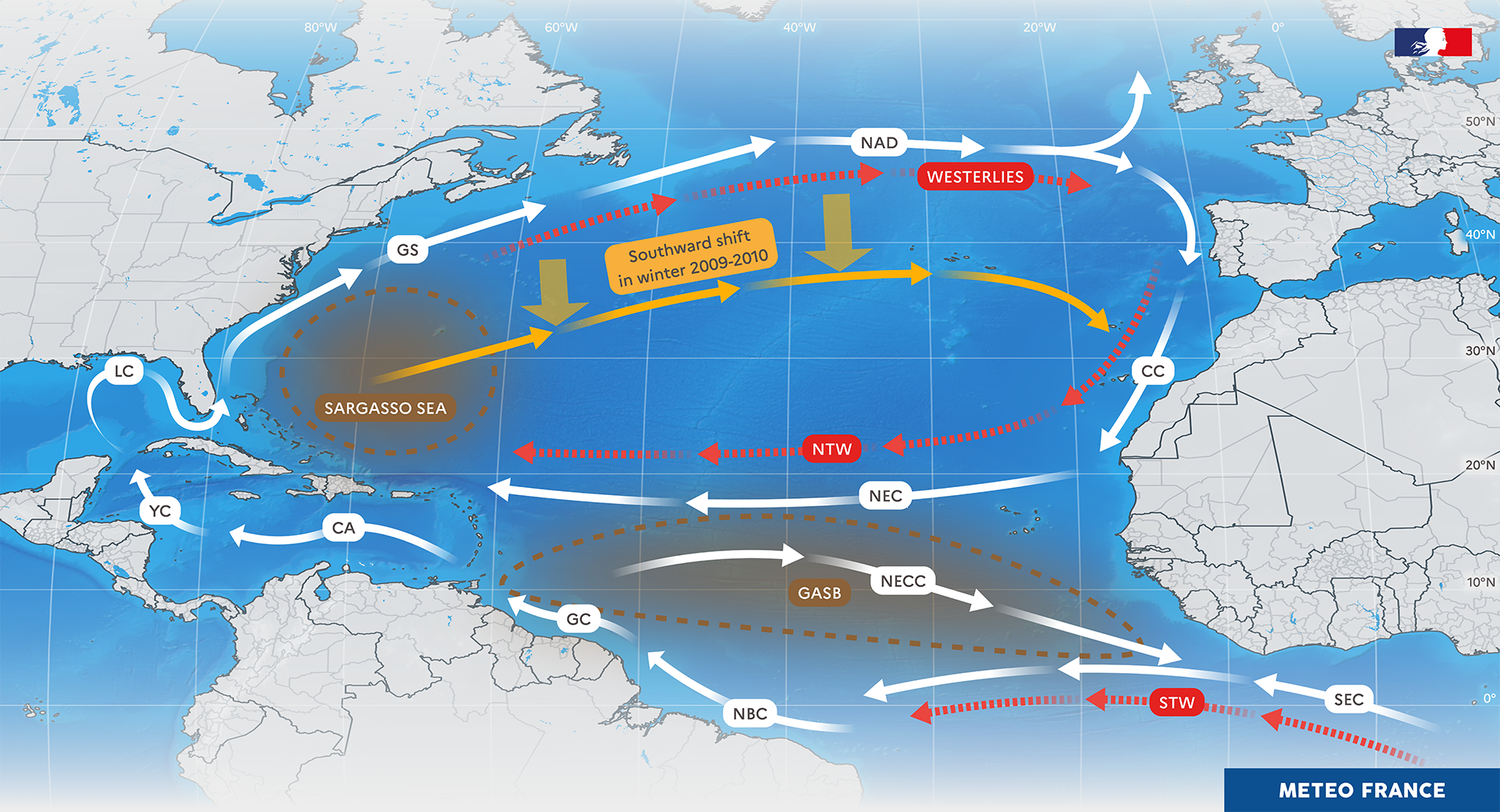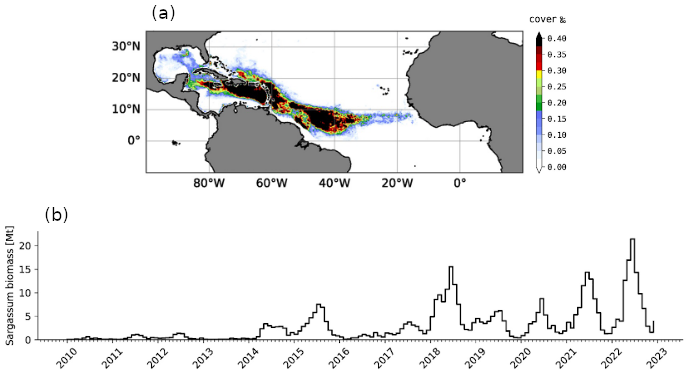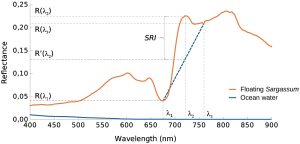The proliferation of large sargassum rafts and their accumulation along the coastlines of the Caribbean region and the West African coast has arisen in 2011 and set a new state of equilibrium in the tropical Atlantic ocean (Fig.1, Johns et al. 2020; Jouanno et al. 2025).

At the scale of the tropical Atlantic, the total sargassum accumulation exhibits notable inter-annual
variations and can reach millions of tons every year.

The factors responsible for the increase in the amounts of sargassum in past years remain poorly understood, and despite recent progress, our capabilities to observe and predict their characteristics and movements remains limited. This new state is maintained by the seasonality of the surface currents and the main ocean-atmosphere coupled modes of variability at the Atlantic basin scale.
The lack of explanation arises from a complex, inter-connected, non-linear variety of atmospheric and oceanic drivers interacting at different scales and the difficulty to observe the processes occurring in these regions.
Given the specific spectral signature of sargassum (Fig.3), ocean colour satellite images are a valuable means to provide basin-scale and periodic quantitative monitoring of the current situation and its variability. At shorter scales, polar-orbiting satellites ensure regular and precise daily monitoring making them key missions for research and operational needs although mainly impacted by the cloud cover and the presence of aerosols. On a broader scale, geostationary satellites, which maintain a fixed position relative to the Earth’s surface, continuously monitor specific basin-scale areas with repeated observations throughout the day. This approach helps mitigate cloud effects and enables the anticipation and the adaptation to problematic situations (such as massive influx) that may arise.

Thus, monitoring the links between sargassum abundance in the Atlantic and environmental
conditions must rely on extensive and more frequent monitoring while integrating different spatial
and temporal scales. Additionally, achieving better anticipation, ranging from hours to months, of
the onset of sargassum rafts and understanding the processes influencing their dynamics and
potential beaching is crucial for reducing risks associated with sargassum in the tropical Atlantic
ocean. This requires accurate modelling of sargassum, their interactions with the surrounding
environment, and fluctuations in atmospheric and oceanic conditions as the life cycle of sargassum
rafts is dependent upon biogeochemical cycles that are influenced and impacted by external factors
and climate change. Many efforts are underway to improve our knowledge and the resulting
adaptation plans, but they depend on the accuracy and quality of detection (Putman et al 2018,
Marsh et al 2023, Jouanno et al 2023). This challenge can be met by a combination of geostationary
observations and coupled ocean-atmosphere biogeochemical modelling approaches, as outlined in
the project SAMOUSSA.
——————————————————————————————————————–
- Johns, E. M., Lumpkin, R., Putman, N. F., Smith, R. H., Muller-Karger, F. E., Rueda-Roa, D. T., … & Werner, F. E. (2020). The establishment of a pelagic Sargassum population in the tropical Atlantic: biological consequences of a basin-scale long distance dispersal event. Progress in Oceanography, 182, 102269. doi.org/10.1016/j.pocean.2020.102269
- Jouanno, J., Berthet, S., Muller-Karger, F., Aumont, O., & Sheinbaum, J. (2025). An extreme North Atlantic Oscillation event drove the pelagic Sargassum tipping point. Communications Earth & Environment, 6(1), 95. doi.org/10.1038/s43247-025-02074-x
- Debue, M., Guinaldo, T., Jouanno, J., Chami, M., Barbier, S., Berline, L., … & Minghelli, A. (2025). Understanding the Sargassum phenomenon in the Tropical Atlantic Ocean: From satellite monitoring to stranding forecast. Marine Pollution Bulletin, 216, 117923. doi.org/10.1016/j.marpolbul.2025.117923
- Putman, N. F., Goni, G. J., Gramer, L. J., Hu, C., Johns, E. M., Trinanes, J., & Wang, M. (2018). Simulating transport pathways of pelagic Sargassum from the Equatorial Atlantic into the Caribbean Sea. Progress in oceanography, 165, 205-214. doi.org/10.1016/j.pocean.2018.06.009
- Marsh, R., Skliris, N., Tompkins, E. L., Dash, J., Dominguez Almela, V., Tonon, T., … & Webber, M. (2023). Climate-sargassum interactions across scales in the tropical Atlantic. Plos Climate, 2(7), e0000253. doi.org/10.1371/journal.pclm.0000253
- Jouanno, J., Morvan, G., Berline, L., Benshila, R., Aumont, O., Sheinbaum, J., & Ménard, F. (2023). Skillful seasonal forecast of Sargassum proliferation in the Tropical Atlantic. Geophysical Research Letters, 50(21), e2023GL105545. doi.org/10.1029/2023GL105545
